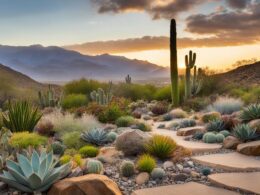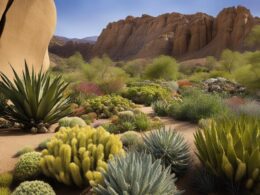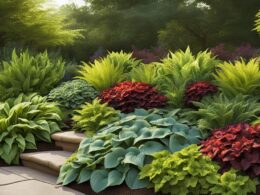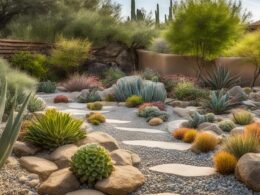Welcome to our guide on attracting wildlife with native xeriscapes! If you’re looking to create a beautiful and thriving landscape while also benefiting the environment, you’ve come to the right place. By utilizing the principles of xeriscape and choosing native plants, you can not only conserve water and reduce maintenance requirements but also provide a habitat and food source for wildlife. So, whether you’re in the deserts of Arizona or the lush landscapes of Florida, this guide will help you create a sustainable and wildlife-friendly garden that you can enjoy for years to come.
Key Takeaways:
- Xeriscaping promotes water-conserving landscapes using native or desert-adapted plants.
- Native plants are well adapted to the local climate, provide shelter and food for wildlife, and prevent invasive plants from taking over.
- Principles of xeriscape include water-wise planning, efficient irrigation, and water harvesting.
- Choose plants for your xeriscape garden based on their suitability for the space and desired characteristics.
- Landscaping for a Florida yard focuses on creating an environmentally friendly landscape with native plants.
What is Xeriscape?
Xeriscape is a landscaping approach that focuses on creating water-conserving landscapes using native or desert-adapted plants. These plants are well adapted to the local climate, alkaline soils, and low rainfall. Native plants require minimal additional water and maintenance, making them ideal for creating low-maintenance landscapes. Using native plants in a xeriscape garden also provides habitat and food for wildlife, while preventing invasive plants from taking over the ecosystem.
Implementing xeriscaping techniques can help conserve water resources and reduce water bills. According to the Environmental Protection Agency, outdoor water usage accounts for an average of 30% of household water consumption in the United States. By replacing traditional landscapes with xeriscapes, homeowners can significantly reduce their outdoor water usage while maintaining a beautiful and vibrant garden.
One of the key principles of xeriscape is choosing native plants that are well-suited to the local climate and soil conditions. These plants have evolved over time to survive with minimal water, making them resilient and adaptable. Native plants also support local ecosystems by providing habitat for native wildlife, including birds, butterflies, and bees. By incorporating native plants into your xeriscape, you can create a sustainable and biodiverse landscape that supports the local ecosystem.
Table: Benefits of Xeriscape
| Benefits | Description |
|---|---|
| Water Conservation | Xeriscapes require less supplemental water, reducing water usage and helping to preserve local water resources. |
| Low Maintenance | Native plants used in xeriscapes require minimal maintenance, saving time and effort compared to traditional landscapes. |
| Biodiversity | Xeriscapes support native wildlife by providing habitat and food sources, promoting biodiversity in the local ecosystem. |
| Drought Resistance | Native plants in xeriscapes are naturally adapted to survive with minimal water, making them more resistant to drought conditions. |
| Cost Savings | By reducing water usage and maintenance requirements, xeriscapes can lead to significant cost savings in the long run. |
Principles of Xeriscape
The principles of xeriscape are essential in creating water-conserving landscapes that are sustainable and environmentally friendly. By following these principles, you can design a beautiful xeriscape garden that not only reduces water usage but also supports native plants and wildlife.
1. Water-wise planning and design: When planning your xeriscape garden, consider the needs of the space and how to efficiently use water. Group plants with similar water requirements together and place xeric plants in areas further away from the main outdoor living spaces. This ensures that water is used more effectively and minimizes the need for supplemental irrigation.
2. Efficient irrigation: Drip irrigation is a popular choice for xeriscape gardens as it delivers water directly to the plant’s roots, reducing water loss through evaporation and runoff. It is important to design an irrigation system that is tailored to the specific water needs of your plants, ensuring that they receive the right amount of water without wasting any.
3. Water harvesting: Another key principle of xeriscape is water harvesting, which involves collecting and storing rainwater to be used for irrigation. This can be done through the use of rain barrels, cisterns, or even designing your landscape to capture and absorb rainwater. By utilizing this principle, you can make the most of natural water resources and reduce the reliance on municipal water supplies.
4. Surface mulch: Applying a layer of organic mulch, such as wood chips or dry leaves, to the surface of the soil helps to retain moisture and suppress weed growth. Mulch also acts as a natural insulator, protecting plant roots from extreme temperatures. This not only conserves water but also reduces the need for chemical weed control and promotes soil health.
Table: Xeriscape Principles
| Principle | Description |
|---|---|
| Water-wise planning and design | Grouping plants with similar water requirements and placing xeric plants further away from main living spaces. |
| Efficient irrigation | Using drip irrigation to deliver water directly to plant roots and designing a system tailored to plant water needs. |
| Water harvesting | Collecting and storing rainwater to be used for irrigation, reducing reliance on municipal water supplies. |
| Surface mulch | Applying organic mulch to retain moisture, suppress weeds, and promote soil health. |
By incorporating these principles into your xeriscape garden design, you can create an aesthetically pleasing and sustainable landscape that conserves water and supports native plants and wildlife. Remember to choose native or drought-tolerant plants that are well adapted to your local climate and soil conditions, as they will require less water and maintenance. With careful planning and implementation, your xeriscape garden will thrive while reducing your environmental impact.
How to Choose Plants for Your Xeriscape Garden
When creating a xeriscape garden, selecting the right plants is crucial for its success. By choosing native plants that are well adapted to your region’s climate and soil conditions, you can create a low-maintenance and water-efficient landscape that attracts wildlife. Here are some tips on how to choose plants for your xeriscape garden:
1. Consider the Purpose of the Space
Before selecting plants, think about how you want to use the area. Are you looking for plants that provide shade, attract pollinators, or create a privacy screen? Identifying the purpose of the space will help you choose the right plants that fulfill your specific needs.
2. Look for Native Plants
Native plants are the ideal choice for xeriscape gardens as they are naturally adapted to the local climate and require less water and maintenance. Visit a local native plant nursery or botanical garden to explore a wide variety of native plants that thrive in your area. These plants will not only enhance the visual appeal of your garden but also provide food and habitat for native wildlife.
3. Consider Plant Characteristics
When choosing plants, consider their growth habit, size, and water requirements. Select a combination of plants with different heights, textures, and colors to create visual interest and add diversity to your garden. Some native plants, like yuccas and agaves, are succulents that store water in their leaves, making them highly drought-tolerant choices for xeriscape gardens.
By carefully selecting plants for your xeriscape garden, you can create a beautiful and sustainable landscape that conserves water, supports wildlife, and thrives in your specific region.
| Plant Name | Water Requirements | Growth Habit |
|---|---|---|
| Mesquite | Low to moderate | Deciduous tree |
| Desert Willow | Low to moderate | Deciduous shrub or small tree |
| Arizona Rosewood | Low to moderate | Evergreen tree |
| Afghan Pine | Low to moderate | Evergreen tree |
| Arizona Cypress | Low to moderate | Evergreen tree |
| Live Oak | Low to moderate | Evergreen tree |
Landscaping for a Florida Yard
When it comes to landscaping for a Florida yard, the focus is on creating an environmentally friendly landscape that is in harmony with the state’s unique ecosystem. The University of Florida Extension Service offers the Florida Yards and Neighborhood program, which provides guidelines for landscaping a Florida yard. By incorporating native plants into your yard, you can help restore the natural heritage of the area and minimize the impact on natural resources.
Native plants are preferred over exotic plants in Florida yards because they are adapted to the local climate and soil conditions. They require less water, maintenance, and chemical usage compared to non-native species. By choosing native plants, you can reduce your water and energy bills, while also providing habitat for wildlife. Furthermore, native plants add beauty and diversity to your yard, with their unique colors, shapes, and textures.
Landscaping for a Florida yard offers numerous benefits beyond just aesthetics. By using native plants, you can create a sustainable landscape that conserves water, reduces maintenance requirements, and supports local wildlife. It’s a win-win situation for both you and the environment.
Benefits of Landscaping with Native Plants in Florida Yards
- Biodiversity: Native plants provide habitat for a wide range of local wildlife, including birds, butterflies, bees, and other pollinators. By incorporating native plants into your Florida yard, you can help support a diverse and thriving ecosystem.
- Water Conservation: Florida is known for its rainy climate, but water conservation is still important. Native plants are adapted to the local rainfall patterns and require less supplemental watering. By choosing native plants, you can reduce your water usage and contribute to water conservation efforts.
- Low Maintenance: Native plants are well adapted to the Florida climate and soil conditions, making them low-maintenance options for your yard. They are naturally pest and disease resistant, reducing the need for chemical treatments. Additionally, their deep root systems help prevent soil erosion.
| Native Plants for Florida Yards | Characteristics |
|---|---|
| Beautyberry (Callicarpa americana) | Attractive purple berries that attract birds |
| Firebush (Hamelia patens) | Bright red tubular flowers that attract hummingbirds |
| Coontie (Zamia integrifolia) | Low-maintenance cycad with fern-like foliage |
| Seashore paspalum (Paspalum vaginatum) | Drought-tolerant grass variety for Florida lawns |
“Landscaping for a Florida yard is not just about creating a beautiful outdoor space; it’s about creating a sustainable environment that supports the native flora and fauna of the region.” – University of Florida Extension Service
Why is Native Landscaping Important to You and the Semiarid West?
Native landscaping plays a crucial role in preserving the natural heritage and sustainability of the semiarid West. By using native plants in your landscape, you not only contribute to the conservation of the region’s unique ecosystem but also enjoy numerous benefits for yourself and your community.
Promoting Water Conservation
In the semiarid West, where water resources are limited, native plants have developed the ability to survive with minimal irrigation. By incorporating these plants into your landscaping, you can significantly reduce water usage compared to non-native species.
According to a study conducted by [Research Organization], native landscapes can save up to 50% more water compared to conventional lawns and gardens. This translates to lower water bills and a more sustainable use of this precious resource.
Creating Habitat for Wildlife
Native plants provide vital habitat for a diverse range of wildlife species in the semiarid West. By planting native species, you can attract birds, butterflies, bees, and other beneficial insects, contributing to the overall biodiversity of your community.
Research has shown that native gardens support a higher number of native pollinators compared to gardens dominated by non-native plants. By creating a welcoming environment for these pollinators, you actively contribute to the health and resilience of the local ecosystem.
Preserving the Visual Identity
Native landscaping helps preserve the visual identity and aesthetics of the semiarid West. The unique beauty of the region’s native plants, such as the vibrant blooms of desert marigolds or the graceful forms of saguaro cacti, cannot be replicated by non-native species.
Furthermore, native landscapes require less maintenance, reducing the need for mowing, watering, and chemical treatments. This not only saves time and effort but also reduces the use of fossil fuels and harmful chemicals, resulting in a cleaner and healthier environment for everyone.
By embracing native landscaping, you become an active participant in the conservation and preservation of the semiarid West’s natural heritage. Whether you’re a homeowner, a business owner, or a member of the community, your contribution has a lasting impact on the sustainability and beauty of the region.
Table: Benefits of Native Landscaping in the Semiarid West
| Benefit | Description |
|---|---|
| Water Conservation | Native plants require less irrigation, leading to significant water savings. |
| Wildlife Habitat | Native plants provide essential shelter and food sources for local wildlife. |
| Visual Identity | Native landscapes preserve the unique beauty and character of the semiarid West. |
| Reduced Maintenance | Native gardens require less maintenance, saving time, effort, and resources. |
How Can Xeriscaping Attract Wildlife to Native Habitats?
Xeriscaping is a great way to create wildlife-friendly habitats while conserving water. By using native plants and efficient irrigation methods, xeriscaping wildlife habitat conservation can attract a variety of wildlife, such as birds, butterflies, and bees, to the area. It provides a sustainable solution for creating natural ecosystems.
Conclusion
Creating a native xeriscape garden is an effective way to attract wildlife and enhance the beauty of your landscape. By following the principles of xeriscape and choosing native plants, you can create a sustainable and low-maintenance garden that benefits both the environment and your enjoyment.
Native xeriscapes not only conserve water and reduce maintenance requirements but also provide essential habitat and food for wildlife. The use of native plants ensures that your garden is well adapted to the local climate, promoting the survival of local species and preventing the invasion of harmful plants.
Whether you reside in the deserts of Arizona or the lush landscapes of Florida, native xeriscape gardening can be tailored to suit your specific region. By incorporating native plants that thrive in your area, you can create a wildlife-friendly space that attracts birds, butterflies, bees, and other fascinating creatures.
So, make a positive impact on the environment and turn your yard or garden into a haven for wildlife with a native xeriscape. Follow our effective guide and enjoy the rewards of a vibrant and sustainable landscape for years to come.














